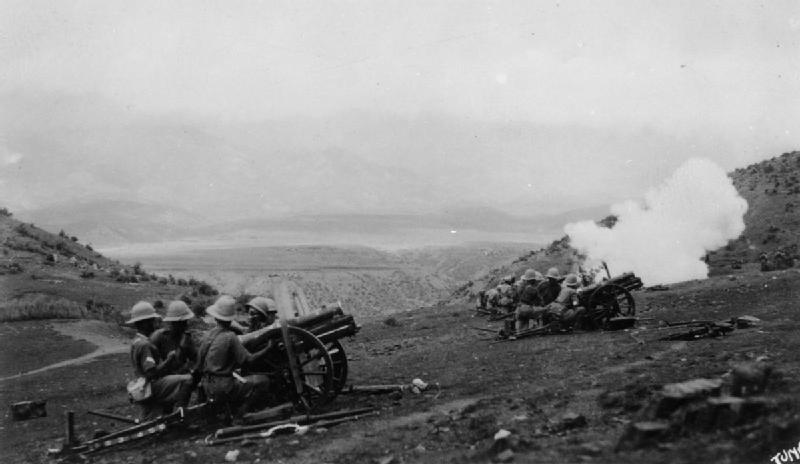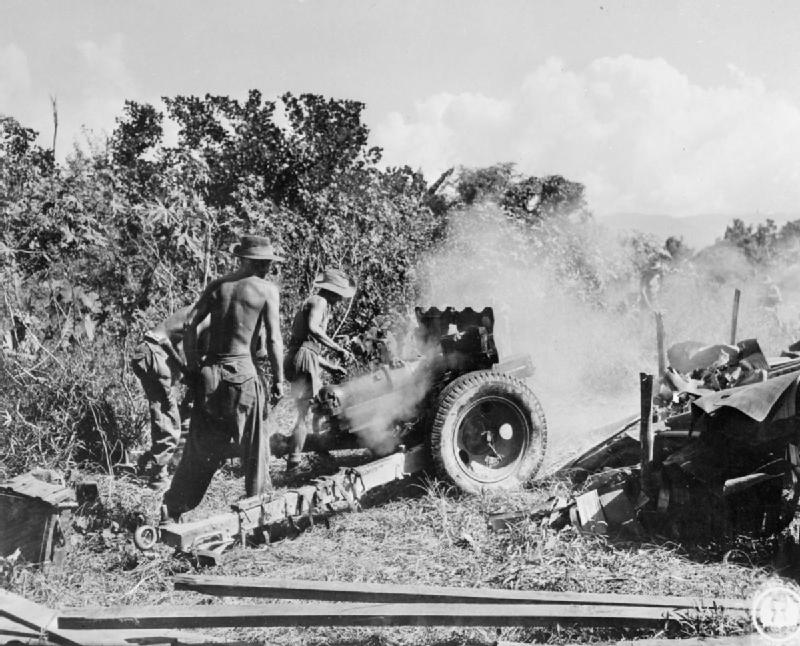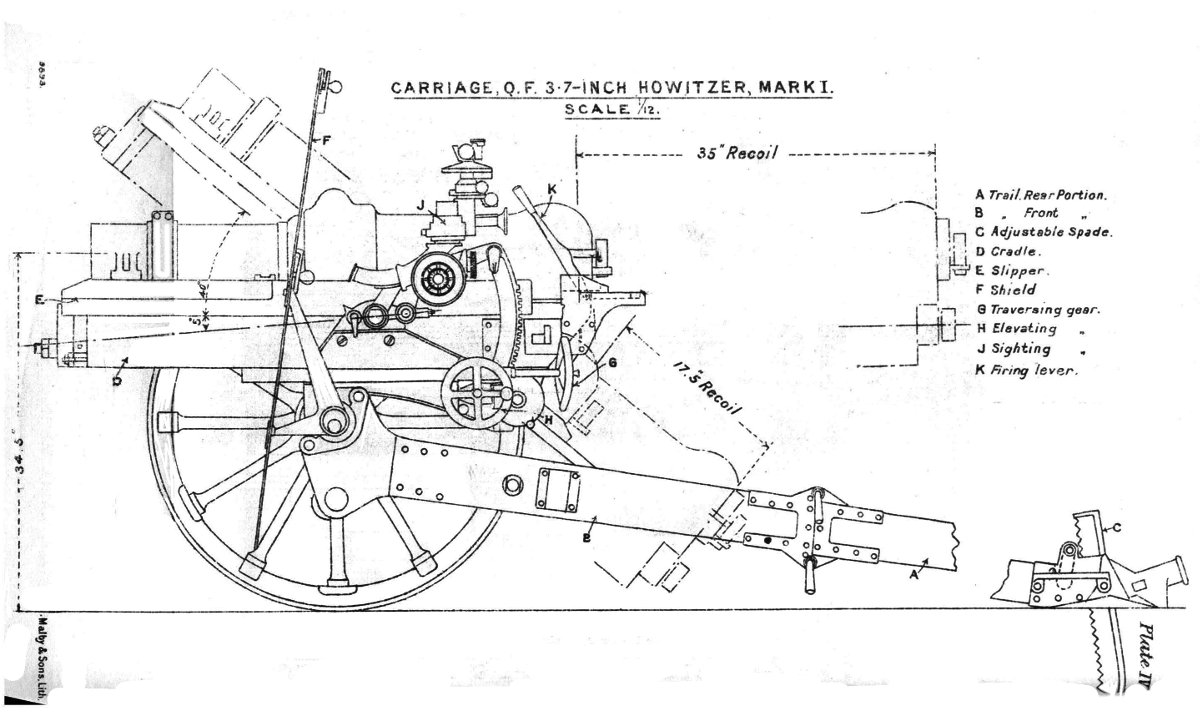QF 3.7-inch Mountain Howitzer on:
[Wikipedia]
[Google]
[Amazon]
Ordnance, QF 3.7-inch howitzer is a
 The 3.7-inch howitzer was first introduced in 1917, and was used in action in that year in the
The 3.7-inch howitzer was first introduced in 1917, and was used in action in that year in the
 The 3.7-inch howitzer superseded the 2.75-inch mountain gun following the
The 3.7-inch howitzer superseded the 2.75-inch mountain gun following the
 During the
During the
/ref> The gun was finally declared obsolete by the British Army in 1960, although it had not seen service since 1945.
 The weapon was designed to be broken into eight mule loads, for transport over difficult terrain. The heaviest single section is the
The weapon was designed to be broken into eight mule loads, for transport over difficult terrain. The heaviest single section is the
File:QF 3.7 inch mountain howitzer cartridge 8 oz 9 drams cordite MD or RDB size 3.75 diagrams.jpg, 8 oz 9 dram
Royal Artillery Museum, Woolwich, London
*1942 Mk I Barrel on Mk II Carriage, at
Army Memorial Museum, Waiouru, New Zealand
*Vietnam Army Museum, Hanoi * Zone 5 Military Museum, Danang *The War Museum of Athens *Example at GEM Homes, Johannesburg South Africa, to be restored shortly (pictures to follow) *Example at Lenz Military Base, Johannesburg, South Africa, to be restored soon. (pictures to follow) *Outside the Military Police Brigade HQ at Camp Cropper Iraq. (as of Jun 2008)
Handbook of the Q.F., 3.7-inch Mountain Howitzer, Mark I, 1921.
Hosted online by State Library of Victoria, Australia
Gun Drill for 3.7-inch Q.F. Howitzer Mark I Carriage Mark I 1921,1923
Hosted online by State Library of Victoria, Australia
* ttps://web.archive.org/web/20090219124649/http://www.ra39-45.pwp.blueyonder.co.uk/guns/ ra39-45.pwpbr>3.7-inch mountain howitzer at Landships
{{DEFAULTSORT:QF 03.7 inch mountain howitzer World War I howitzers World War I artillery of the United Kingdom World War II artillery of the United Kingdom Mountain artillery World War I mountain artillery World War II mountain artillery 94 mm artillery
mountain gun
Mountain guns are artillery pieces designed for mountain warfare and other areas where wheeled transport is not possible. They are generally capable of being taken apart to make smaller loads for transport by horses, humans, mules, tractors, or ...
, used by British and Commonwealth
A commonwealth is a traditional English term for a political community founded for the common good. The noun "commonwealth", meaning "public welfare, general good or advantage", dates from the 15th century. Originally a phrase (the common-wealth ...
armies in the First and Second World Wars
World War II or the Second World War (1 September 1939 – 2 September 1945) was a World war, global conflict between two coalitions: the Allies of World War II, Allies and the Axis powers. World War II by country, Nearly all of the wo ...
, and between the wars.
History
TheBritish Indian Army
The Indian Army was the force of British Raj, British India, until Indian Independence Act 1947, national independence in 1947. Formed in 1895 by uniting the three Presidency armies, it was responsible for the defence of both British India and ...
first requested a modern mountain gun
Mountain guns are artillery pieces designed for mountain warfare and other areas where wheeled transport is not possible. They are generally capable of being taken apart to make smaller loads for transport by horses, humans, mules, tractors, or ...
in 1906 to replace the BL 10 pounder Mountain Gun, which had been hastily developed after the Second Boer War
The Second Boer War (, , 11 October 189931 May 1902), also known as the Boer War, Transvaal War, Anglo–Boer War, or South African War, was a conflict fought between the British Empire and the two Boer republics (the South African Republic and ...
, but had several shortcomings. In particular, the shell weight was seen as too light, and the gun lacked any recoil absorber or recuperator
A recuperator (electro- end carbogidro-) - is a special purpose countercurrent exchange, counter-flow energy recovery heat exchanger positioned within the supply and exhaust air streams of an air handling system, or in the exhaust gases of an in ...
, meaning the gun had to be relaid after every shell was fired. However, financial constraints delayed production of the 3.7-inch weapon until 1915. As a stop-gap, the barrel of the 10-pounder gun was mounted on an updated carriage to produce the 2.75 inch Mountain Gun.
First World War
 The 3.7-inch howitzer was first introduced in 1917, and was used in action in that year in the
The 3.7-inch howitzer was first introduced in 1917, and was used in action in that year in the Mesopotamian Campaign
The Mesopotamian campaign or Mesopotamian front () was a campaign in the Middle Eastern theatre of World War I fought between the British Empire, with troops from United Kingdom of Great Britain and Ireland, Britain, Australia and the vast major ...
(modern Iraq area).
The 22nd (Derajat) Indian Frontier Force mountain battery arrived in the East Africa campaign on 18 December 1916, when they relieved the 28th Battery which returned to India. They appear to have re-equipped from the 10-pounder mountain gun to the 3.7-inch howitzer while in East Africa, and first used the new weapon in action in an attack on German positions at Medo, 11 April 1918.
Interwar years
 The 3.7-inch howitzer superseded the 2.75-inch mountain gun following the
The 3.7-inch howitzer superseded the 2.75-inch mountain gun following the First World War
World War I or the First World War (28 July 1914 – 11 November 1918), also known as the Great War, was a World war, global conflict between two coalitions: the Allies of World War I, Allies (or Entente) and the Central Powers. Fighting to ...
. It was used by mountain artillery regiments of the Royal Artillery
The Royal Regiment of Artillery, commonly referred to as the Royal Artillery (RA) and colloquially known as "The Gunners", is one of two regiments that make up the artillery arm of the British Army. The Royal Regiment of Artillery comprises t ...
and the Indian Artillery, and saw much service on the North West Frontier of India between the wars.
Second World War
 During the
During the Second World War
World War II or the Second World War (1 September 1939 – 2 September 1945) was a World war, global conflict between two coalitions: the Allies of World War II, Allies and the Axis powers. World War II by country, Nearly all of the wo ...
, the weapon equipped artillery units engaged in the North African Campaign
The North African campaign of World War II took place in North Africa from 10 June 1940 to 13 May 1943, fought between the Allies and the Axis Powers. It included campaigns in the Libyan and Egyptian deserts (Western Desert campaign, Desert Wa ...
(Tunisia
Tunisia, officially the Republic of Tunisia, is a country in the Maghreb region of North Africa. It is bordered by Algeria to the west and southwest, Libya to the southeast, and the Mediterranean Sea to the north and east. Tunisia also shares m ...
), the Italian Campaign, the Kokoda Campaign, and Burma Campaign
The Burma campaign was a series of battles fought in the British colony of British rule in Burma, Burma as part of the South-East Asian theatre of World War II. It primarily involved forces of the Allies of World War II, Allies (mainly from ...
, and was also used in the Netherlands and Ruhr
The Ruhr ( ; , also ''Ruhrpott'' ), also referred to as the Ruhr Area, sometimes Ruhr District, Ruhr Region, or Ruhr Valley, is a polycentric urban area in North Rhine-Westphalia, Germany. With a population density of 1,160/km2 and a populati ...
fighting in 1944–45 by units originally destined for mountain warfare in Greece. In the latter theatre, on occasion the gun was dismantled and manually hauled up to the upper floors of buildings to provide close support in urban fighting. A lightened version was used briefly by airborne formations. Several were supplied to the French Army after 1945; one is on display at the Vietnam Army Museum in Hanoi while another is displayed at the Zone 5 Military Museum, Danang. It was also used on Close Support versions of the A9 and A10 Cruiser Tanks in place of the standard 2 pounder, though mostly to fire smoke shells.
During the war the gun, and its ammunition, were also manufactured in other Commonwealth countries, including South Africa, by the ISCOR (Iron and Steel Corporation of South Africa), and India. South Africa also produced modified versions of the gun.British Artillery in the Second World War: The 3.7-inch howitzer/ref> The gun was finally declared obsolete by the British Army in 1960, although it had not seen service since 1945.
Post War
After the war, the gun was used by French forces during theFirst Indochina War
The First Indochina War (generally known as the Indochina War in France, and as the Anti-French Resistance War in Vietnam, and alternatively internationally as the French-Indochina War) was fought between French Fourth Republic, France and Việ ...
and by India
India, officially the Republic of India, is a country in South Asia. It is the List of countries and dependencies by area, seventh-largest country by area; the List of countries by population (United Nations), most populous country since ...
during the Indo-Pakistani wars of 1965 and 1971 *
The year 1971 had three partial solar eclipses (Solar eclipse of February 25, 1971, February 25, Solar eclipse of July 22, 1971, July 22 and Solar eclipse of August 20, 1971, August 20) and two total lunar eclipses (February 1971 lunar eclip ...
. The "Mujib Battery" of Bangladesh
Bangladesh, officially the People's Republic of Bangladesh, is a country in South Asia. It is the List of countries and dependencies by population, eighth-most populous country in the world and among the List of countries and dependencies by ...
used this gun in 1971's Bangladesh Liberation War
The Bangladesh Liberation War (, ), also known as the Bangladesh War of Independence, was an War, armed conflict sparked by the rise of the Bengali nationalism, Bengali nationalist and self-determination movement in East Pakistan, which res ...
. They were provided by India
India, officially the Republic of India, is a country in South Asia. It is the List of countries and dependencies by area, seventh-largest country by area; the List of countries by population (United Nations), most populous country since ...
to the Mukti Bahini
The Mukti Bahini, initially called the Mukti Fauj, also known as the Bangladesh Forces, was a big tent armed guerrilla resistance movement consisting of the Bangladeshi military personnel, paramilitary personnel and civilians during the Ba ...
.
Details
 The weapon was designed to be broken into eight mule loads, for transport over difficult terrain. The heaviest single section is the
The weapon was designed to be broken into eight mule loads, for transport over difficult terrain. The heaviest single section is the interrupted screw
file:Breech 122m10 hameenlinna 2.jpg, Breech from Russian 122 mm M1910 howitzer, modified and combined with 105 mm H37 howitzer barrel
An interrupted screw or interrupted thread is a mechanical device typically used in the Breech-loadi ...
breech, which weighs . Given an open gun position, a practised crew could have the guns unloaded from the mules, reassembled and deployed ready for action in about two minutes. The 3.7-inch howitzer's adjustable suspension system allowed it to be deployed on almost any position, even those too uneven or with too steep a gradient to allow field artillery to be sited. The process of removing the howitzer from a position and reloading it onto the gun mules involved much more lifting and securing loads than deploying it, but could be accomplished in three minutes in favourable conditions.
The howitzer has a split trail
A gun carriage is a frame or a mount that supports the gun barrel of an artillery piece, allowing it to be maneuvered and fired. These platforms often had wheels so that the artillery pieces could be moved more easily. Gun carriages are also use ...
, the first British weapon to do so, which allows firing at very high angles (a useful feature in mountainous terrain). It also has a large rectangular shield to protect the crew from small-arms fire, but this was often omitted to save weight. When it was first introduced, the howitzer had two wooden wheels and was light enough be towed by two horses. Later marks have pneumatic tyres and could be towed by any light vehicle, such as the Bren Carrier or jeep
Jeep is an American automobile brand, now owned by multi-national corporation Stellantis. Jeep has been part of Chrysler since 1987, when Chrysler acquired the Jeep brand, along with other assets, from its previous owner, American Motors Co ...
.
The propellant casing had five "charge zones", but HE was restricted to no more than "charge four", to prevent premature detonation of the shell. The Australian Army did employ charge five in Papua New Guinea in emergencies – the gun crews referred to it as "O'Hara's charge".
Ammunition
cordite
Cordite is a family of smokeless propellants developed and produced in Britain since 1889 to replace black powder as a military firearm propellant. Like modern gunpowder, cordite is classified as a low explosive because of its slow burni ...
cartridge
File:QF 3.7 inch mountain howitzer shrapnel shell diagram.jpg, Shrapnel shell
Shrapnel shells were anti-personnel artillery munitions that carried many individual bullets close to a target area and then ejected them to allow them to continue along the shell's trajectory and strike targets individually. They relied almost ...
File:QF 3.7 inch mountain howitzer HE shell Mark I diagram.jpg, Mark I HE shell
File:QF 3.7 inch mountain howitzer gas shell Mark I diagram.jpg, Mark I gas shell
See also
*List of mountain artillery
Mountain artillery, which includes pack howitzers, mountain howitzers and mountain guns, is designed to accompany mountain infantry forces. Usually lightweight and designed to be broken down to be portable by pack animals or even soldiers, they ...
Surviving examples
Royal Artillery Museum, Woolwich, London
*1942 Mk I Barrel on Mk II Carriage, at
Imperial War Museum Duxford
Imperial War Museum Duxford, also known as IWM Duxford or simply Duxford, is a branch of the Imperial War Museum near Duxford in Cambridgeshire, England. Duxford, Britain's largest aviation museum, houses exhibits, including nearly 200 aircraf ...
, UK.
* Bangladesh Military Museum, Dhaka
Dhaka ( or ; , ), List of renamed places in Bangladesh, formerly known as Dacca, is the capital city, capital and list of cities and towns in Bangladesh, largest city of Bangladesh. It is one of the list of largest cities, largest and list o ...
* Israel Defense Forces History Museum (Batey ha-Osef Museum), Tel Aviv
Tel Aviv-Yafo ( or , ; ), sometimes rendered as Tel Aviv-Jaffa, and usually referred to as just Tel Aviv, is the most populous city in the Gush Dan metropolitan area of Israel. Located on the Israeli Mediterranean coastline and with a popula ...
Army Memorial Museum, Waiouru, New Zealand
*Vietnam Army Museum, Hanoi * Zone 5 Military Museum, Danang *The War Museum of Athens *Example at GEM Homes, Johannesburg South Africa, to be restored shortly (pictures to follow) *Example at Lenz Military Base, Johannesburg, South Africa, to be restored soon. (pictures to follow) *Outside the Military Police Brigade HQ at Camp Cropper Iraq. (as of Jun 2008)
Notes and references
Bibliography
* * *External links
Handbook of the Q.F., 3.7-inch Mountain Howitzer, Mark I, 1921.
Hosted online by State Library of Victoria, Australia
Gun Drill for 3.7-inch Q.F. Howitzer Mark I Carriage Mark I 1921,1923
Hosted online by State Library of Victoria, Australia
* ttps://web.archive.org/web/20090219124649/http://www.ra39-45.pwp.blueyonder.co.uk/guns/ ra39-45.pwpbr>3.7-inch mountain howitzer at Landships
{{DEFAULTSORT:QF 03.7 inch mountain howitzer World War I howitzers World War I artillery of the United Kingdom World War II artillery of the United Kingdom Mountain artillery World War I mountain artillery World War II mountain artillery 94 mm artillery